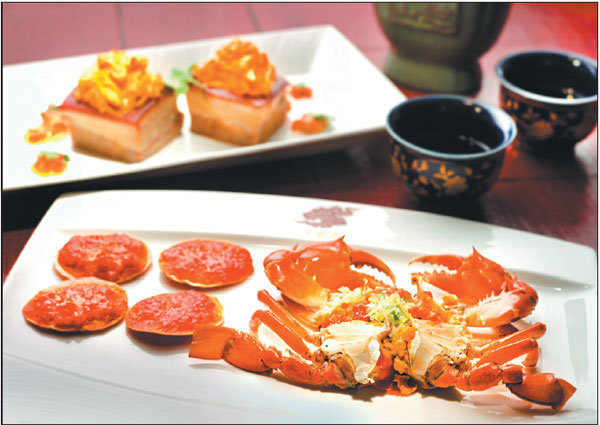Cantonese Rebound
By Mike Peters (China Daily) Updated: 2017-06-30 10:20A Hong Kong native who grew up in Canada rediscovers her birth culture through food, Mike Peters reports.
Adele Wong was born in Hong Kong, but her family emigrated to Toronto in the early 1990s.
"My favorite foods changed from deep-fried fish balls from a hawker food cart," she says, "to baked potatoes with butter and chives".
Things could have stayed that way, but a job offer brought Wong back to the island nine years ago. She suddenly found herself on a voyage of rediscovery - "a huge dose of reverse culture shock" - absorbing her original heritage by exploring Hong Kong's rich culinary scene.
The result is Hong Kong Food & Culture: From Dim Sum to Dried Abalone, which won an award last month at the 2017 Gourmand Awards competition for cookbooks in Yantai. But Wong's 345-page volume is much more than a recipe collection.
The former dining columnist at HK Magazine, Wong started her own publishing company and lifestyle website (theloophk.com) several years ago. She "hates being pigeon-holed as a food writer," she says, and the book is a triumphant effort to break such boundaries.
When she writes about soy sauce, for example, she explains how it's made from fermented soybeans, wheat flour, water and salt; how it's used in the kitchen; the differences between light and dark versions. But then she grabs the readers hand for a joyous jaunt to the Kowloon Soy factory in Yuen Long, where the company still dries its fermented soybean culture the traditional way - by loading everything into massive clay vats and letting the sun do its job.
Owner Ken Wong, who is part of the original family that founded the brand, concedes that it takes three or four months to make soy sauce this way, as opposed to the much quicker chemical process many competitors use today.
"A lot of the time, we cannot produce enough to match demand," he says. "And when it's raining, our numbers are affected." But the resulting product, he insists, tastes and smells better than the more industrially made sauces.
The book is peppered with visits to similar inheritors of Hong Kong's culinary crafts, and readers can follow the author through the steps of making oyster sauce and proper shrimp paste - and blending older and newly harvested rice to produce a bowl with the perfect texture.
Wong also uses her dining columnist experience to take us around the city's restaurant scene. We learn that the bing sutt ("ice room") diners were offering cold drinks in pre-refrigeration days when such beverages were a luxury, while cha chaan teng ("tea restaurant") evolved as a more sophisticated version of the hawker stall. Today both serve similar menus of Western-influenced yet Cantonese-style snacks and dishes. The Western influence, of course, dates from the British colonial period after World War II, long before hipster foodies were talking about fusion. Breakfast options include sandwiches filled with scrambled eggs and either ham, spam or minced beef - or instant noodles dunked in satay beef broth.
"Yeung Chow Fried Rice is a common cha chaan teng item: it's a yellow-colored rice... that gets its hue from the quick mixing of a raw egg into the rice while it's cooking in the wok."
Wong visits more controversial aspects of Cantonese cuisine in a detached way. She observes that shark's-fin soup is prized in Cantonese fine dining and banquet menus for its unique texture, but notes that many restaurants have dropped it from their menus due to the socially frowned upon way shark fins are harvested.
Seafood of all kinds, naturally, is celebrated in a coastal city where seafood markets and restaurants are clustered cheek-to-jowl, and many Hong Kongers stop at a market first before popping over to a restaurant to hand over their personal daily catch to the chef.
"Flower crabs would be steamed with Chinese wine," she writes, "while mud crabs are commonly subjected to typhoon shelter-style treatment (deep-fried with golden garlic chips, chilies, spring onion and fermented soybean paste). Typhoon shelters are little havens along Hong Kong's coast where fishermen's boats take refuge from the storms; the dinners made by fishermen were eventually known as typhoon shelter-style cooking".
While readers will savor such tidbits of foodie culture - along with photographer Alan Pang's mouthwatering images - there is the succulent promise of a few carefully chosen recipes. Sprinkled through the text are easy-to-follow how-tos for homemade char siu, street fare like pan-fried "three treasures", and claypot rice with preserved meat.
"Roast meats are a rare home kitchen endeavor," she notes, "because of the equipment, labor and time involved." But Wong offers a short-cut version of char siu "that you can easily replicate without breaking your back".
Contact the writer at michaelpeters@chinadaily.com.cn
|
Golden crab at Tin Lung Heen restaurant in Hong Kong.Photos Provided To China Daily |
- 'Cooperation is complementary'
- Worldwide manhunt nets 50th fugitive
- China-Japan meet seeks cooperation
- Agency ensuring natural gas supply
- Global manhunt sees China catch its 50th fugitive
- Call for 'Red Boat Spirit' a noble goal, official says
- China 'open to world' of foreign talent
- Free trade studies agreed on as Li meets with Canadian PM Trudeau
- Emojis on austerity rules from top anti-graft authority go viral
- Xi: All aboard internet express












